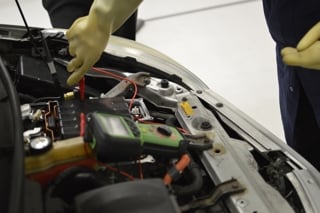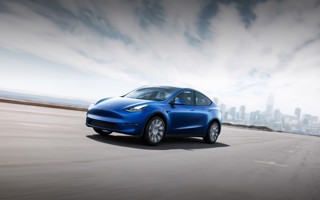Increasing demand for minerals used in electric vehicle (EV) batteries, such as lithium, nickel and cobalt, is pushing up prices and threatens to disrupt production.
The warning from industry analysts comes as lithium prices have risen tenfold to $75,000 (£61,000) a tonne since the start of 2021.
Bloomberg Intelligence, in its Europe Autos 2023 Outlook report, says that escalating battery costs and battery demand could be the industry's next bottleneck after suffering months of disruption from the semiconductor shortage.
THE NUMBER OF NEW PROJECTS
To meet soaring global EV demand, the International Energy Agency forecasts the sector will require 50 new lithium projects, 60 nickel mines and 17 cobalt developments by 2030.
Owen Edwards, head of downstream automotive at Grant Thornton UK, said: “It is not clear whether there will be sufficient supply of raw materials to satisfy demand.”
Commodity price reporting agency Fastmarkets NewGen says that regionally sourced supply is not expected to meet regional demand, even with planned projects and government policies such as the recent American Battery Materials Initiative aimed at strengthening US domestic supply chains.
The largest single source of demand for lithium, EVs contributed 58% of total lithium demand in 2021. Fastmarkets NewGen forecast this will rise to 76% in 2032.
Battery EV sales, the leading source of demand, are forecast to reach to 50 million units in 2032, up from 4.6 million units in 2021.
It also expects that Europe will represent 25% of lithium demand by 2032, but will contribute only 4% of global lithium supply.
Similarly, the US will represent 8% of demand, but only 6% of supply.
Currently, Australia produces the lion’s share of lithium, which is extracted from hard rock mines and turned into a concentrate that is then predominantly refined in China.
In an effort to secure supply of raw materials vital in the production of EVs, carmakers are beginning to invest upstream, in the mining sector.
“Downstream players are looking to invest further upstream,” explained Lenaig Trenaux, global head mining, metals and industries finance at ALD Automotive’s parent company Société Générale.
“We’ve recently seen a big trend in that direction; where you have OEMs making direct equity investments in mining companies or mining projects, or even providing funding to make sure they can accelerate the development of new mines and get security of supply.”
McKinsey has forecast global lithium production will increase from 540,000 tonnes in 2021 to as much as 3.2 million tonnes annually by the end of the decade, dependent on the pace of new project completion.
However, Fastmarkets NewGen forecasts that it will remain a tight market: a surplus of 90,000 tonnes represents 3% of total demand in 2031, and some oscillation between deficit and surplus in certain years is likely with consequently high volatility in prices.
GOING DIRECT TO PRODUCERS
Tesla has led the way in securing raw materials for batteries, but several manufacturers, frustrated by supply chain disruption, have recently stepped up their own efforts to secure resources by going directly to producers.
General Motors agreed to pre-pay Livent, a lithium mining group, $200m (£164m) to secure supplies, while Ford is funding Liontown Resources to develop a lithium mine.
Furthermore, Stellantis has taken a €50m (£43m) equity stake in Vulcan Energy Resources, which aims to produce lithium in Germany.
Mercedes-Benz, meanwhile, has agreed to buy future output from suppliers to help raise financing and has begun work on its own processing facilities.
Chinese EV companies have been pursuing this strategy for some time. BYD, the world’s largest EV producer, has been trying to secure access to lithium mines in Africa and Chile.
In addition, the world’s largest maker of batteries, Contemporary Amperex Technology, recently agreed to buy a near 25% stake in cobalt producer CMOC (previously known as the China Molybdenum Company) for about $3.7 billion (£2bn).
Trenaux says such manufacturer moves address any risk from a gap in supplies and is also "very important in terms of traceability".
However, she warns that the supply of raw materials remains a challenge and there is a need for further investment in the mineral sector to meet increasing demand.
Investment also needs to be across the value chain, according to Trenaux. “You have to extract the minerals from the ground, but you also need to process them before they can be put into a battery,” she explained.
“Take lithium, for example, you have a lot of lithium deposits all over the world, but the processing capacities today are mostly in China. It's a challenge that needs to be addressed.”
HIGH SUSTAINABILITY STANDARDS
Trenaux also highlighted how many of the minerals crucial to the chemistry of an EV battery are in “challenging jurisdictions”, both politically and environmentally.
Three-quarters (75%) of the world's cobalt production, for example, comes from the Democratic Republic of the Congo (DRC). “It is not an easy country to deal with, so that's another challenge,” she said.
Accelerating production will be key, but Trenaux explained that this also needs to be done in a “sustainable manner” without “any shortcuts”.
Stéphane Rénie, head of corporate social responsibility at ALD Automotive, shares Trenaux’s sustainability concerns. “We cannot afford another dieselgate with electric vehicles,” he said.
“We must ensure from an ethical perspective that the 'mine to wheel' cycle on EVs follows higher ethical, environmental and social standards than has been the case in the ICE (internal combustion engine) world.”
In the United States, the Inflation Reduction Act, signed by President Biden, includes provisions aimed at boosting domestic manufacturing of EVs and batteries, including new sourcing requirements for vehicles to qualify for tax credits.
IMPACT ON EV LIST PRICES
Industry estimates suggest that the battery accounts for between 40-60% of a battery electric vehicle (BEV) price, while 60% of the battery cost is estimated to be down to the minerals.
As a result, Grant Thornton and Cox Automotive say rising raw material costs are increasing retail prices. Philip Nothard, insight and strategy director at Cox Automotive, explained: “Due to ‘pass-through’ contracts, battery manufacturers do not incur the cost of raw material price hikes; these are attributed to OEMs.
“Not wishing to see margins drop significantly, vehicle OEMs have been forced to pass on the additional cost to consumers.”
Citifirst suggests it is costing manufacturers more than $10,000 (£8,248) extra for a BEV, the upshot of a hefty battery price tag for minerals.
The ideal is that EVs deliver cost parity with ICE vehicles, for which it is widely regarded that battery prices need to reach less than $100 (£82) per kilowatt-hour (kWh). But the economic and competitive physics do not currently point in that direction.
Figures from Bloomberg New Energy Finance show the inflation adjusted price of battery packs for cars was $1,200 (£989) per kWh in 2010. This had fallen to $132 (£108) last year.
Assuming a kWh price of $132, it would have cost $6,000 (£4,948) to produce a 50kWh battery last year. In 2010, this would have been $60,000 (£49,488).
However, due to mineral costs increasing, battery costs are now expected to rise to $138 (£113) per kWh in 2024.
CHANGING BATTERY TECHNOLOGY
Manufacturers are working hard to develop batteries which are less reliant on materials such as cobalt. This is changing battery chemistry, which gives both the battery and BEVs distinctive characteristics – charging speed, energy density and range.
Edwards, of Grant Thornton UK, said: “There are three key battery chemistry technologies for BEVs: NMC (nickel manganese cobalt), NCA (nickel cobalt aluminium) and LFP (lithium iron phosphate).
“Battery chemistry has traditionally focused on NMC and NCA; looking ahead, however, demand for LFP is expected to increase.”
LFP batteries are not as powerful as NMC and NCA ones, but they come at a lower cost and contain no cobalt. “These are just some of the reasons why Tesla uses this technology in its batteries for the new Tesla 3 series,” added Edwards.
Tesla has diversified its battery chemistry from NCA to NCM to LFP batteries, now found in the latest Tesla Model 3 manufactured in China.
Nothard added: “OEMs are encouraged to adopt a similar strategy – reduce costs by selecting different raw materials and battery technologies and, simultaneously, generate the optimum power density while maintaining battery safety.
“Ultimately, the pay-off between cost, power density and battery safety is key; with the reduction in battery costs due to improved technology, vehicle OEMs are moving towards the cost of manufacturing a BEV at parity with ICE vehicles.”
Trenaux acknowledges there is a lot of work being done on battery technology to try to be less dependent on certain raw materials. However, she says that those emerging battery technologies will still rely on minerals.
To read more from Philip Nothard, insight and strategy director at Cox Automotive, on why EV battery raw material scarcity matters for retailers, click here.
























Login to comment
Comments
No comments have been made yet.